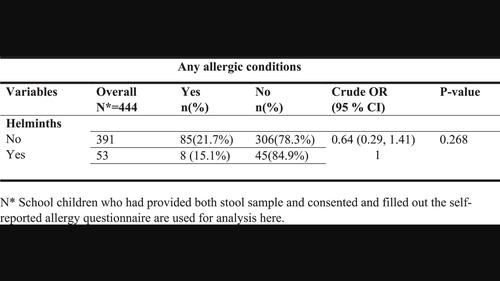当前位置:
X-MOL 学术
›
Immun. Inflamm. Dis.
›
论文详情
Our official English website, www.x-mol.net, welcomes your feedback! (Note: you will need to create a separate account there.)
Association between helminth infection and allergic disorders among children in Batu, Ethiopia
Immunity, Inflammation and Disease ( IF 2.493 ) Pub Date : 2024-03-22 , DOI: 10.1002/iid3.1222 Sosina Walelign 1 , Mheret Tesfaye 2 , Geremew Tasew 3 , Kassu Desta 1 , Aster Tsegaye 1 , Bineyam Taye 4
Immunity, Inflammation and Disease ( IF 2.493 ) Pub Date : 2024-03-22 , DOI: 10.1002/iid3.1222 Sosina Walelign 1 , Mheret Tesfaye 2 , Geremew Tasew 3 , Kassu Desta 1 , Aster Tsegaye 1 , Bineyam Taye 4
Affiliation

|
BackgroundHelminths are potent immunomodulators and in their chronic infection state they may protect against allergy‐related disease and atopy. However, they are also known for inducing allergic conditions. This study aimed to assess the association between helminths, atopy and allergic conditions.MethodsA total of 461 school children participated in this cross‐sectional study. Data on allergic symptoms and a range of confounding variables was gathered from parents via an interviewer‐led questionnaire. Skin sensitization to house dust mite and cockroaches was analyzed, and a stool sample was collected for helminth analysis. Serum total Immunoglobulin E using enzyme‐linked immunosorbent assay and eosinophil count were also measured.ResultsOverall sensitivity to both allergens was 2.4%. Self‐reported allergic outcomes in the last 12 months for the 461 participants had been : wheezing 3.7%, asthma 2.2%, eczema 13.2% and hay fever 6.9%. Overall, the prevalence of helminth infection was 11.9% (53/444). A borderline significant association was found between atopy and any allergy symptoms (odds ratio [OR]: 3.32, 95% confidence interval [95% CI: 0.99, 11.1], p = .052). There was no significant association between helminths and atopy (OR: 0.64 [95% CI: 0.29, 1.41], p = .268) and also between helminths and allergic symptoms (OR: 0.64 [95% CI: 0.29, 1.41], p = .268). Bivariate analysis showed keeping an animal in the house increases the risk of atopy while maternal and paternal history of allergy increases the risk of developing allergic symptoms in the children.Conclusion and clinical relevanceThis study found a non‐significant inverse association between helminths infection and atopy and allergic disorders, likely due to reduced statistical power, resulting in a lower prevalence of atopy and allergic conditions. A high powered longtitudinal study is necessary to explore the casuality and potential therapeutic benefits of helminths for allergic disorders.
中文翻译:

埃塞俄比亚巴图儿童蠕虫感染与过敏性疾病之间的关联
背景蠕虫是有效的免疫调节剂,在慢性感染状态下,它们可以预防过敏相关疾病和特应性。然而,它们也因诱发过敏而闻名。本研究旨在评估蠕虫、特应性和过敏性疾病之间的关联。方法共有 461 名学童参与了这项横断面研究。有关过敏症状和一系列混杂变量的数据是通过访谈者主导的问卷从父母那里收集的。分析了皮肤对屋尘螨和蟑螂的敏感性,并收集粪便样本用于蠕虫分析。还使用酶联免疫吸附测定法测量了血清总免疫球蛋白 E 和嗜酸性粒细胞计数。结果对两种过敏原的总体敏感性为 2.4%。 461 名参与者在过去 12 个月内自我报告的过敏结果为:喘息 3.7%、哮喘 2.2%、湿疹 13.2% 和花粉热 6.9%。总体而言,蠕虫感染率为11.9% (53/444)。发现特应性和任何过敏症状之间存在显着相关性(比值比 [OR]:3.32,95% 置信区间 [95% CI:0.99, 11.1],p =.052)。蠕虫和过敏症之间没有显着相关性(OR:0.64 [95% CI:0.29,1.41],p = .268)以及蠕虫和过敏症状之间的差异(OR:0.64 [95% CI:0.29,1.41],p = .268)。双变量分析显示,在家中饲养动物会增加特应性的风险,而母亲和父亲的过敏史会增加儿童出现过敏症状的风险。结论和临床相关性本研究发现,蠕虫感染与特应性和过敏性之间不存在显着的负相关。过敏性疾病,可能是由于统计功效降低,导致特应性和过敏性疾病的患病率较低。有必要进行一项高水平的纵向研究来探索蠕虫对过敏性疾病的危害和潜在的治疗益处。
更新日期:2024-03-22
中文翻译:

埃塞俄比亚巴图儿童蠕虫感染与过敏性疾病之间的关联
背景蠕虫是有效的免疫调节剂,在慢性感染状态下,它们可以预防过敏相关疾病和特应性。然而,它们也因诱发过敏而闻名。本研究旨在评估蠕虫、特应性和过敏性疾病之间的关联。方法共有 461 名学童参与了这项横断面研究。有关过敏症状和一系列混杂变量的数据是通过访谈者主导的问卷从父母那里收集的。分析了皮肤对屋尘螨和蟑螂的敏感性,并收集粪便样本用于蠕虫分析。还使用酶联免疫吸附测定法测量了血清总免疫球蛋白 E 和嗜酸性粒细胞计数。结果对两种过敏原的总体敏感性为 2.4%。 461 名参与者在过去 12 个月内自我报告的过敏结果为:喘息 3.7%、哮喘 2.2%、湿疹 13.2% 和花粉热 6.9%。总体而言,蠕虫感染率为11.9% (53/444)。发现特应性和任何过敏症状之间存在显着相关性(比值比 [OR]:3.32,95% 置信区间 [95% CI:0.99, 11.1],



























 京公网安备 11010802027423号
京公网安备 11010802027423号